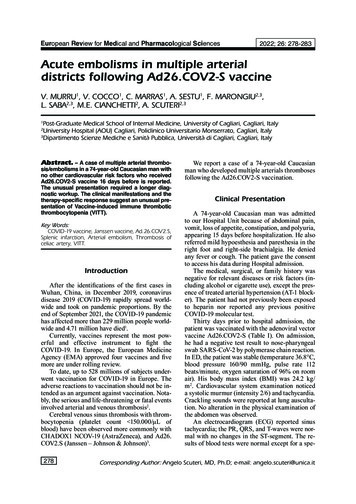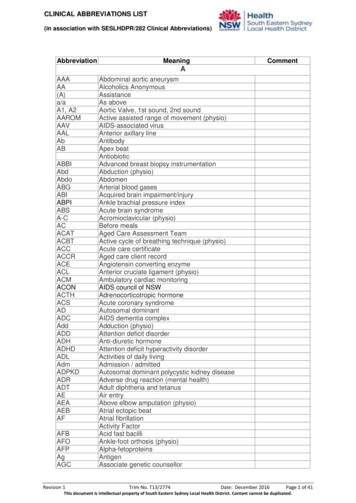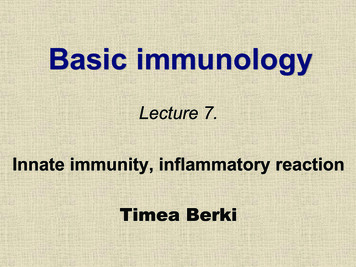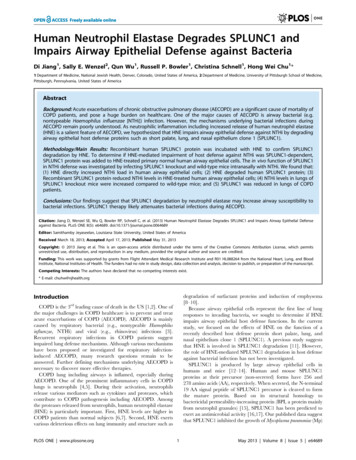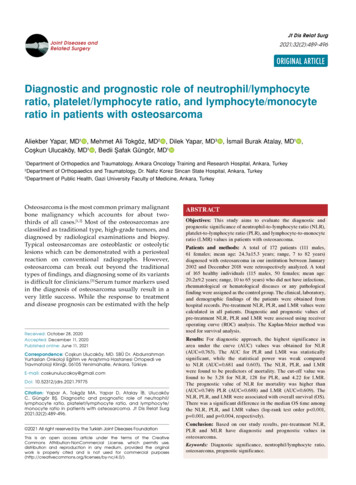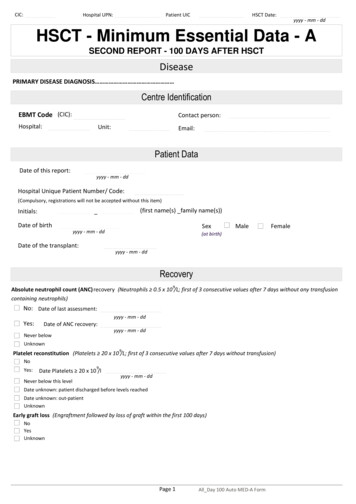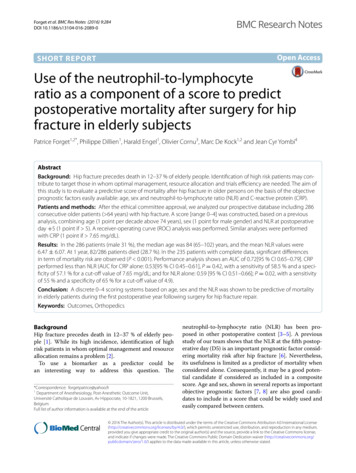
Transcription
Forget et al. BMC Res Notes (2016) 9:284DOI 10.1186/s13104-016-2089-0BMC Research NotesOpen AccessSHORT REPORTUse of the neutrophil‑to‑lymphocyteratio as a component of a score to predictpostoperative mortality after surgery for hipfracture in elderly subjectsPatrice Forget1,2*, Philippe Dillien1, Harald Engel1, Olivier Cornu3, Marc De Kock1,2 and Jean Cyr Yombi4AbstractBackground: Hip fracture precedes death in 12–37 % of elderly people. Identification of high risk patients may contribute to target those in whom optimal management, resource allocation and trials efficiency are needed. The aim ofthis study is to evaluate a predictive score of mortality after hip fracture in older persons on the basis of the objectiveprognostic factors easily available: age, sex and neutrophil-to-lymphocyte ratio (NLR) and C-reactive protein (CRP).Patients and methods: After the ethical committee approval, we analyzed our prospective database including 286consecutive older patients ( 64 years) with hip fracture. A score [range 0–4] was constructed, based on a previousanalysis, combining age (1 point per decade above 74 years), sex (1 point for male gender) and NLR at postoperativeday 5 (1 point if 5). A receiver-operating curve (ROC) analysis was performed. Similar analyses were performedwith CRP (1 point if 7.65 mg/dL).Results: In the 286 patients (male 31 %), the median age was 84 (65–102) years, and the mean NLR values were6.47 6.07. At 1 year, 82/286 patients died (28.7 %). In the 235 patients with complete data, significant differencesin term of mortality risk are observed (P 0.001). Performance analysis shows an AUC of 0.72[95 % CI 0.65–0.79]. CRPperformed less than NLR (AUC for CRP alone: 0.53[95 % CI 0.45–0.61], P 0.42, with a sensitivity of 58.5 % and a specificity of 57.1 % for a cut-off value of 7.65 mg/dL; and for NLR alone: 0.59 [95 % CI 0.51–0.66]; P 0.02, with a sensitivityof 55 % and a specificity of 65 % for a cut-off value of 4.9).Conclusion: A discrete 0–4 scoring systems based on age, sex and the NLR was shown to be predictive of mortalityin elderly patients during the first postoperative year following surgery for hip fracture repair.Keywords: Outcomes, OrthopedicsBackgroundHip fracture precedes death in 12–37 % of elderly people [1]. While its high incidence, identification of highrisk patients in whom optimal management and resourceallocation remains a problem [2].To use a biomarker as a predictor could bean interesting way to address this question. The*Correspondence: forgetpatrice@yahoo.fr1Department of Anesthesiology, Post‑Anesthetic Outcome Unit,Université Catholique de Louvain, Av Hippocrate, 10‑1821, 1200 Brussels,BelgiumFull list of author information is available at the end of the articleneutrophil-to-lymphocyte ratio (NLR) has been proposed in other postoperative context [3–5]. A previousstudy of our team shows that the NLR at the fifth postoperative day (D5) is an important prognostic factor considering mortality risk after hip fracture [6]. Nevertheless,its usefulness is limited as a predictor of mortality whenconsidered alone. Consequently, it may be a good potential candidate if considered as included in a compositescore. Age and sex, shown in several reports as importantobjective prognostic factors [7, 8] are also good candidates to include in a score that could be widely used andeasily compared between centers. 2016 The Author(s). This article is distributed under the terms of the Creative Commons Attribution 4.0 International /), which permits unrestricted use, distribution, and reproduction in any medium,provided you give appropriate credit to the original author(s) and the source, provide a link to the Creative Commons license,and indicate if changes were made. The Creative Commons Public Domain Dedication waiver ) applies to the data made available in this article, unless otherwise stated.
Forget et al. BMC Res Notes (2016) 9:284Based on a previous work [6], the aim of this study is toevaluate a predictive score of mortality after hip fractureon the basis of these objective variables (age and sex), toevaluate its performance in the elderly patients of our hipfracture registry, and to consider the added value of theNLR (at D5, defined as 5 days after surgery) to the score.A second aim is to consider the potential performance ofanother inflammatory biomarker, the C-reactive protein(CRP), as an alternative to the NLR.Patients and methodsPage 2 of 6ObjectivesOur first objective is to construct and evaluate the performance of a predictive risk score, based on the threemost important and objective risk factors for mortalityidentified in our cohort of patients 64 years with hipfracture: age, sex and NLR 5 at D5 after surgery [6].Our second objective is to compare, in this context, thepotential performance of the CRP, as a potential alternative to the NLR, as prognostic significance of CRP wasnot analyzed in our previous report.PatientsPlanification of surgery and postoperative careAfter the approval of the ethical committee (CEBHF ofthe Université catholique de Louvain, Chairperson: PrJ.-M. Maloteaux, n 2010/23DEC/406), that waived usfrom written informed consent for this observationalstudy, we analyzed our prospective database including286 consecutive patients, undergoing surgery for hipfracture, from September 2010 to February 2012. Thesedata were registered and managed by the physician incharge of the patients (JCY) in agreement with the Belgian law.All the patients were taken in charge following the sameprotocol, including early surgery [10] (87.7 % of surgeries were done within the first 24 h, 95.4 % within the first48 h). All surgeries were performed by the same team,coordinated by OC. As recommended, clinical follow-upwas made by a multidisciplinary medical team (surgeons,geriatricians, anesthesiologists, with a coordinating general internist, JCY) [11].Design and data collectionData collection was systematized and standardizedusing computerized medical charts. Age, sex, comorbidities, NLR and CRP values were registered. Regarding the NLR value, we introduced it as a binary variable(NLR 5 or not) as proposed by Proctor et al. [9]. Indeed,we assumed the possibility of a non-linear impact of theNLR-value on outcome. To manage the risk of an empirical cut-off, proposed by Proctor et al, we completed previously the analysis by a pre-planned ROC curve analysis.This analysis permitted to confirm that the most discriminant NLR value was 4.9, associated with a sensitivity of62.9 % and a specificity of 57.6 % for mortality prediction(P 0.01) [6]. This findings permitted to use the Proctoret al’s threshold (NLR 5) and to consider it for subsequent analyses.Survival data were obtained from the Belgian nationalregistry, in accordance to the national laws, permitting acomplete, and high-quality, follow-up. Cause of death isnot investigated. In this series, we found similar risk factors for mortality than in the literature: age, male genderand multiple comorbidities (defined here as: cirrhosis,arterial hypertension, COPD, vascular disease, coronaropathy, other cardiomyopathy—including chronic heartfailure, diabetes mellitus, dementia, anaemia necessitating blood transfusion) [6]. Compared to the literature,the various definitions of the multiple comorbid statusprecludes definitive comparison. Therefore, we limitedour model to objective risk factors.Blood analysesBlood analyses were performed as following. All venousblood samples were processed in a blood analyzer [Sysmex (TOA Medical Electronics, Kobe, Japan)] for thedetermination of the complete blood cell counts anddifferential counts of leukocytes. We recorded the neutrophils and the lymphocytes counts, and calculated theNLR. The CRP was determined by turbidimetry [UniCel DxC 800 (Beckman Coulter, Pasadena, California, USA)]on a serum sample.Statistical analysisData are presented as mean SD, number (percentage)and median (range) or percentage [95 % confidence interval, CI]. Factors considered here for the constructionof the score were selected as the three most importantobjectives ones previously identified [6]. The coefficientsassociated with these factors were used to construct apredictive score.Construction of a predictive scoreA methodology, derived from this used previously byApfel et al. [12], was used. The following formula permitted risk probability modelisation (1 e z) 1 withz b1 . x1 b2 . x2 b3 . x3 by . xy with b asthe coefficient calculated in the regression model and xthe parameter. For this work, the following coefficientswere obtained from a previous regression model (thehazard ratio–HR—for the mortality risk) [6]: Age by10 year-increments: 2.08 [95 % CI 1.37–3.17]; male gender: 1.92 [95 % CI 1.17–3.14] and NLR 5 at day 5: 1.8
Forget et al. BMC Res Notes (2016) 9:284[95 % CI 1.11–2.94] (P 0.05 for all the analyses concerning mortality risk at 1 year). Taking into account that noadditional risk of death correspond to 1, b was obtainedconsidering the HR 1 with b1 1; b2 1 and b3 1.A receiver-operating curve (ROC) curve analysis wasplanned to determine the performance of the score, byreporting the area under the curve (AUC). Result wasconsidered by some authors as associated with correctperformance if equal or more than 0.7 [13]. AnotherROC curve analysis was planned to compare the performance of the CRP and this of the NLR values, as without these markers. For survival analysis, Kaplan–Meieranalyses were used with log-rank test. In all the analyses,P 0.05 was considered as significant. Analyses wereperformed using the software STATISTICA (7, StatsoftInc. 2004) and SPSS Statistics (17.0, Polar Engineeringand Consulting 2008).ResultsPatientsFrom the 286 patients included, 235 were retained inthe final analyses. Causes are lack of NLR and/or CRPdata at D5 (n 49, 17.1 %) and lost-of-follow-up dueto departure to another country (n 2, 0.7 %). In these235 patients (72 males and 163 females, 30.6 %/69.4 %),median age is 84 (range: 65 to 102) years. Mean NLR values at day 5 are 6.47 6.07. Proportion of patients with aNLR at D5 5 is 46.0 % (n 108/235). At 1 year, 82/286patients died (28.7 %) [14]. These proportions were similar in the 51 patients excluded (19 males and 32 females,37.2 %/62.7 %), with a median age of 84 (range: 65–96)years, and mortality at 1 year of 15/49 (30.6 %) (P 0.05for all comparisons with patients retained with the finalanalyses).Construction of a predictive scoreBased on the previously observed coefficient factors, ageis considered as decades in the score (0 point from 65 to74 years, 1 point from 75 to 84 years and 2 points above84 years). One point is added for males. To see whetherthese risk factors are sufficient to construct a score (ranging from 0 to 3), we did a performance analysis of thisscore that reveals no predictive value, with an AUC of0.52 [95 % CI 0.43–0.60] (P 0.69 vs. AUC 0.5).As planned, NLR 5 at D5 after surgery was considered in the score, with one additional point when positive. Then, a score ranging from 0 to 4 is obtained for allthe patients (Table 1). Distributions of the score in all theseries [median: 2 (0 to 4)], in survivors [2 (0 to 4)] andnon-survivors [3 (1 to 4)] are presented in Fig. 1. Performance of the test analysis shows an AUC of 0.72 [95 %CI 0.65–0.79] (P 0.001) (Fig. 2). This score is thereforeconsidered in subsequent analyses.Page 3 of 6Table 1 Proposed score, ranging from 0 to 4, to predictmortality after hip fractureAge (years)65 to 74 075 to 84 1Above 84 2SexNLR 5 at postoperative day 5Male 1If yes 1Female 0Based on the previously observed coefficient factors, age is considered asdecades in the score (0 point from 65 to 74 years, 1 point from 75 to 84 years and2 points above 84 years). One point is added for males. Performance analysis ofthis score, ranging from 0 to 3, reveals no predictive value, with an AUC of 0.52[95 % CI 0.43–0.60] (P 0.69 vs. AUC 0.5)As planned, NLR 5 at D5 after surgery was considered in the score, with oneadditional point when positive. Then, a score ranging from 0 to 4 is obtained forall the patientsMortality at 1 year in regards to the score valueCumulative survival curves are presented in Fig. 3.Graphical analysis confirms a gradual increase in themortality risk associated with the predictive score. Logrank test confirms a highly statistically significant difference (P 0.001).CRP vs. NLRMean CRP values at day 5 are 10.32 7.02. The AUCare 0.53 [95 % CI 0.45–0.61] (P 0.42 vs. AUC 0.5)and 0.59 [95 % CI 0.51–0.66](P 0.02 vs. AUC 0.5)respectively for CRP and NLR. Optimal cut-off valuesare 7.65 mg/dL, for the CRP, and 4.9 for the NLR. Proportion of patients with a CRP at D5 7.65 mg/dL is54.9 % (n 129/235). Consequently, unsatisfactory (i.e. 0.7) AUC values, concerning 1-year mortality, with theCRP and the NLR taken alone are confirmed. In addition,results show that CRP shows no potential interest in acomposite score in contrast with the NLR (P 0.05 vs.AUC 0.5).DiscussionWe constructed and tested here a predictive score formortality at 1 year after hip fracture in elderly patients( 64 years). The score comes from three objective parameters available at D5 after surgery: sex, age and NLR 5,giving a value from 0 (a woman, between 65 and 74 years,with a NLR 5 at D5) to 4 (a man, older than 84 years,with a NLR 5 at D5). This score presents a predictiveperformance, with an AUC of 0.72 [95 % CI 0.65–0.79].In our analyses, CRP does not show any advantage onNLR. It is true when comparing directly CRP to NLRperformances, and when included in the score.There are already models in the literature like theCharlson comorbidity index (CCI). But, in their study,Neuhaus et al. [15] conclude that, while the CCI predicted in-hospital mortality in patients with hip fractures,other factors may be of value in patients with trauma. The
Forget et al. BMC Res Notes (2016) 9:284Fig. 1 Score distributions the 235 patients of more than 64 yearsafter surgery for hip fracture. Score is based on sex (1 male), age(1 more than 74 years, 2 more than 84 years) and NLR at day 5 (1if NLR 5). Survivor/non-survivor status were assessed at one yearFig. 2 Performance analysis of a the NLR (a), the CRP (b) values, or apredictive score (c) for mortality at one year in a series of 235 patientsof more than 64 years after surgery for hip fracture. Score is based onsex (1 male), age (1 more than 74 years, 2 more than 84 years)and NLR at D5 (1 if 5). Areas under the curve (AUC) are, for NLR, 0.59[95 % CI 0.51–0.66](P 0.02 vs. AUC 0.5) with an with an optimalcut-off value of 4.9 (a); for CRP, 0.53 [95 % CI 0.45–0.61](P 0.42 vs.AUC 0.5), with an optimal cut-off value of 7.65 mg/dL (b), and, forthe composite score, 0.72 [95 % CI 0.65–0.79] (P 0.001 vs. AUC 0.5)Page 4 of 6CCI has been developed for patients without trauma [16]and it is based on comorbidities [17], parameters whichwe do not consider in our score, as our approach aimedto restrict us to objective parameters. Furthermore wewant a score to predict mortality when the patients haveleft the hospital and our score can be seen as simpler asbased on only three factors. However, our score lacks ofmajor advantages of the CCI: excellent performance (Cstatistics of more than 0.85) and multiple validations inmany different centres.The Nottingham hip fracture score developed by Maxwell et al. [18] is also interesting. This score originallyintended to measure mortality at 30 day (and mostly validated for). In a second study, it was showed that it couldalso be used to predict 1-year mortality after HF [19].However it takes into account many parameters and cannot be easily calculated at the bedside without the help ofelectronic tools. For the same reason we were not satisfied with the score created by Jiang et al [20].Concerning the importance of the NLR in the score, itcan be said that the acute, as the persisting (possibly inpatient with preexisting vascular disease), inflammatoryresponse observed after a vascular lesion or an ischemicevent is, at least partially, activated by activated neutrophils [21–23]. With platelets, neutrophils participate toendothelial dysfunction, the destabilization of atherosclerotic plaques and coagulation enhancement, inducing further vascular damage [24, 25]. These effects aredependent of the magnitude and the duration of theresponse [26, 27]. This does not exclude the possibilityis that NLR on day 5 is a marker of frailty, with a stressinduced hormonal changes includes cortisol secretion,which increases the neutrophil count and reduces thelymphocyte count. All these possibilities may contributeto the fact that mortality at 1 year is higher in patientswith a NLR 5 at D5.Limits are linked to the design of our work that can beconsidered as an internal validation of the study score.Indeed, the data serving to identify the prognostic factorswere, at least partially, dependent from these serving totest the score (i.e. coming from a previous version of thesame registry). Nevertheless, as the chosen parametersare objective (sex, age, NLR at D5), an external validation in another institution will be easy to perform. Oneimportant bias could be the exclusion of the 49 patientswith incomplete data. However, all the relevant data (riskfactors) were similar between included and excludedpatients, especially survival (P 0.05). Finally, to increasethe usefulness of the score, it will be interesting to compare it with other methods and scores. Indeed, as thescore is obtained only at D5, it is not sure whether normal
Forget et al. BMC Res Notes (2016) 9:284Fig. 3 Overall survival curves at one year (Kaplan–Meier analysis) in aseries of 235 patients of more than 65 years after surgery for hip fracture. Score is based on sex (1 male), age (1 more than 74 years,2 more than 84 years) and NLR at D5 (1 if 5)clinical experience would be not as well estimated. Moreover, an AUC of 0.72 underlies a significant proportion offalse positive and negative results.ConclusionWe have developed a score to predict the risk of mortality at 1 year in elderly patients after surgery for a hip fracture. The score is based on age, sex and the NLR at D5.After external validation, it may be included in clinicalpractice as in clinical research to stratify the risk of postoperative mortality.Author’s contributionsPF, PD, HE, OC, MDK and JCY were involved in study concept and design; PD,HE, OC and JCY in acquisition of subjects and/or data; PF analysed the data;all the authors participated to the interpretation of data. All authors read andapproved the final manuscript.Author details1Department of Anesthesiology, Post‑Anesthetic Outcome Unit, UniversitéCatholique de Louvain, Av Hippocrate, 10‑1821, 1200 Brussels, Belgium. 2 Institute of Neuroscience (Pôle CEMO), Université Catholique de Louvain, Brussels,Belgium. 3 Department of Orthopedic and Traumatologic Surgery, UniversitéCatholique de Louvain, Brussels, Belgium. 4 Department of Internal and Perioperative Medicine, Cliniques Universitaires Saint‑Luc, Université Catholique deLouvain, Brussels, Belgium.AcknowledgementsThe authors would like to thank Benoit Boland, M.D. Ph.D., for his help thorough the finalisation process.Competing interestsThe authors declare that they have no competing interests.Received: 9 May 2016 Accepted: 13 May 2016Page 5 of 6References1. Tajeu GS, Delzell E, Smith W, Arora T, Curtis JR, Saag KG, Morrisey MA, YunH, Kilgore ML. Death, debility, and destitution following hip fracture. JGerontol A Biol Sci Med Sci. 2014;69(3):346–53.2. Nikitovic M, Wodchis WP, Krahn MD, Cadarette SM. Direct health-carecosts attributed to hip fractures among seniors: a matched cohort study.Osteoporos Int. 2013;24(2):659–69.3. Bhutta H, Agha R, Wonq J, Tanq TY, Wilson YG, Walsh SR. Neutrophillymphocyte ratio predicts medium-term survival following electivemajor vascular surgery: a cross-sectional study. Vasc Endovascular surg.2011;45(3):227–31.4. Cook EJ, Walsh SR, Faroog N, Alberts JC, Justin TA, Keeling NJ. Postoperative Neutrophil-lymphocyte ratio predicts complications followingcolorectal surgery. Int J Surg. 2007;5(1):27–30.5. Vaughan-Shaw P, Rees JR, King A. Neutrophil lymphocyte ratio in outcome prediction after emergency abdominal surgery in the elderly. Int JSurg. 2012;10(3):157–62.6. Forget P, Moreau N, Engel H, Cornu O, Boland B, De Kock M, Yombi JC. Thepostoperative neutrophil-to-lymphocyte ratio (NLR) is an important riskfactor of worse outcome and mortality after surgery for hip fracture. ArchGerontol Geriatr. 2014;S0167–4943(14):00220–9.7. Kannegaard PN, van der Mark S, Eiken P, Abrahamsen B. Excess mortalityin men compared with women following a hip fracture: national analysisof comedications, comorbidity and survival. Age Ageing. 2010;39:203–9.8. Meessen JM, Pisani S, Gambino ML, Bonarrigo D, van Schoor NM, FozzatoS, Cherubino P, Surace MF. Assessment of mortality risk in elderly patientsafter proximal femoral fracture. Orthopedics. 2014;37(2):e194–200.9. Proctor MJ, Morrison DS, Talwar D, Balmer SM, Fletcher CD, O’Reilly DS,Foulis AK, Horgan PG, Mc Millan DC. A comparison of inflammationbased prognostic scores in patients with cancer. A Glasgow inflammationoutcome study. Eur J Cancer. 2011;47(17):2633–41.10. Simunovic N, Deveraux PJ, Sprague S, et al. Effect of early surgery afterhip fracture on mortality and complications: systematic review and metaanalysis. CMAJ. 2010;182(15):1609–16.11. Hung WW, Egol KA, Zuckerman JD, Siu AL. Hip fracture management,tailoring care for the older patient. JAMA. 2012;20:307.12. Apfel CC, Greim CA, Haubitz I, Goepfert C, Usadel J, Sefrin P, Roewer N. Arisk score to predict the probability of postoperative vomiting in adults.Acta Anaesthesiol Scand. 1998;42:495–501.13. Hanley JA, McNeil BJ. The meaning and use of the area under a receiveroperating characteristic (ROC) curve. Radiology. 1982;143(1):29–36.14. Haleem S, Lutchman L, Mayahi R, Grice JE, Parker MJ. Mortality followinghip fracture: trends and geographical variations over the last 40 year.Injury. 2008;39(10):1157–63.15. Neuhaus V, King J, Hageman MG. Ring DC Charlson comorbidity indicesand in-hospital deaths in patients with hip fractures. Clin Orthop RelatRes. 2013;471(5):1712–9.16. Gabbe BJ, Magtengaard K, Hannaford AP, Cameron PA. Is the Charlsoncomorbidity index useful for predicting trauma outcomes? Acad EmergMed. 2005;12:318–21.17. Charlson M, Szatrowski TP, Peterson J, Gold J. Validation of a combinedcomorbidity index. J Clin Epidemiol. 1994;47:1245–51.18. Maxwell MJ, Moran CG, Moppett IK. Development and validation ofa preoperative scoring system to predict 30 day mortality in patientsundergoing hip fracture surgery. Br J Anaesth. 2008;101(4):511–7.19. Wiles MD, Moran CG, Sahota O, Moppett IK. Nottingham hip fracturescore as a predictor of one year mortality in patients undergoing surgicalrepair of fractured neck of femur. Br J Anaesth. 2011;106(4):501–4.20. Jiang HX, Majumdar SR, Dick DA, Moreau M, Raso J, Otto DD, JohnstonDW. Development and initial validation of a risk score for predicting inhospital and 1-year mortality in patients with hip fractures. J Bone MinerRes. 2005;20(3):494–500.21. Torre-Amione G, Kapadia S, Benedict C, Oral H, Young JB, Mann DL. Proinflammatory cytokine levels in patients with depresses left ventricularejection fraction: a report from the Studies of left ventricular dysfunction.J Am Coll Cardiol. 1996;27:1201–6.
Forget et al. BMC Res Notes (2016) 9:28422. Mann DL, Young JB. Basic mechanisms in congestive heart failure: recognizing the role of proinflammatory cytokines. Chest. 1994;105:897–904.23. Wang R, Chen PJ, Chen WH. Diet and exercise improve neutrophilto lymphocyte ratio in overweight adolescents. Int J Sports Med.2011;32(12):982–6.24. Tousoulis D, Antoniades C, Koumallos N, Stefanadis C. Proinflammatorycytokines in acute coronary syndromes: from bench to bedside. CytokineGrowth Factor Rev. 2006;17:225–33.25. Turkmen K, Guney I, Yerlikaya FH, Tonbul HZ. The relationship betweenneutrophil-to-lymphocyte ratio and inflammation in end-stage renaldisease patients. Ren Fail. 2012;34(2):155–9.Page 6 of 626. Guasti L, Dentali F, Castiglioni L, Maroni L, Marino F, Squizzato A, AgenoW, Gianni M, Gaudio G, Grandi AM, Cosentino M, Venco A. Neutrophilsand clinical outcomes in patients with acute coronary syndromes and/or cardiac revascularisation. A systematic review on more than 34,000subjects. Thromb Haemost. 2011;106(4):591–9.27. Inoue T, Croce K, Morooka T, Sakuma M, Node K, Simon DI. Vascularinflammation and repair: implications for re-endothelialization, restenosis,and stent thrombosis. JACC Cardiovasc Interv. 2011;4(10):1057–66.Submit your next manuscript to BioMed Centraland we will help you at every step: We accept pre-submission inquiries Our selector tool helps you to find the most relevant journal We provide round the clock customer support Convenient online submission Thorough peer review Inclusion in PubMed and all major indexing services Maximum visibility for your researchSubmit your manuscript atwww.biomedcentral.com/submit
mex (TOA Medical Electronics, Kobe, Japan)] for the determination of the complete blood cell counts and differential counts of leukocytes. We recorded the neu-trophils and the lymphocytes counts, and calculated the NLR. The CRP was determined by turbidimetry [UniCel DxC 800 (Beckman Coulter, Pasadena, California, USA)] on a serum sample.


